|
New economic data abounded during the week but investor attention was focused on the upcoming G20 and the meeting between the U.S. and China in an attempt to break the logjam on trade between the countries. Brexit continued to churn with December 11 a key date for a Parliamentary vote on the prime minister’s plan. And the minutes of the most recent FOMC meeting were parsed as were speeches by Chair Powell and Vice Chair Clarida.
Trade ministers for the U.S., Mexico, and Canada in an early-morning event signed the recast North American Free Trade Agreement. It was held in Buenos Aires on the sidelines of a Group of 20 summit of advanced and developing economies. It came a day before President Trump is scheduled to hold a high-stakes dinner there with Chinese President Xi Jinping, as the two leaders discuss their escalating spat of tariffs and counter-tariffs. Comments from members of the administration sent investors’ spirits yo-yoing depending upon what was said.
Equities improved their performance in November when most of the indexes advanced on the month in stark contrast to October when all tumbled.
| |
|
2017 |
2018 |
% Change |
|
Index |
Dec 29 |
Nov 23 |
Nov 30 |
Week |
Nov |
2018 |
| Asia/Pacific |
|
|
|
|
|
|
|
| Australia |
All Ordinaries |
6167.3 |
5793.4 |
5749.3 |
-0.8% |
-2.8% |
-6.8% |
| Japan |
Nikkei 225 |
22764.9 |
21646.6 |
22351.1 |
3.3% |
2.0% |
-1.8% |
|
Topix |
1817.56 |
1628.96 |
1667.5 |
2.4% |
1.3% |
-8.3% |
| Hong Kong |
Hang Seng |
29919.2 |
25927.7 |
26506.8 |
2.2% |
6.1% |
-11.4% |
| S. Korea |
Kospi |
2467.5 |
2057.5 |
2096.9 |
1.9% |
3.3% |
-15.0% |
| Singapore |
STI |
3402.9 |
3052.5 |
3117.6 |
2.1% |
3.3% |
-8.4% |
| China |
Shanghai Composite* |
3307.2 |
2579.5 |
2588.2 |
0.3% |
-0.6% |
-21.7% |
|
|
|
|
|
|
|
|
| India |
Sensex 30 |
34056.8 |
34981.02 |
36194.3 |
3.5% |
5.1% |
6.3% |
| Indonesia |
Jakarta Composite |
6355.7 |
6006.2 |
6056.1 |
0.8% |
3.8% |
-4.7% |
| Malaysia |
KLCI |
1796.8 |
1695.9 |
1679.9 |
-0.9% |
-1.7% |
-6.5% |
| Philippines |
PSEi |
8558.4 |
7340.2 |
7367.9 |
0.4% |
3.2% |
-13.9% |
| Taiwan |
Taiex |
10642.9 |
9667.3 |
9888.0 |
2.3% |
0.9% |
-7.1% |
| Thailand |
SET |
1753.7 |
1622.1 |
1641.8 |
1.2% |
-1.6% |
-6.4% |
|
|
|
|
|
|
|
|
| Europe |
|
|
|
|
|
|
|
| UK |
FTSE 100 |
7687.8 |
6952.9 |
6980.2 |
0.4% |
-2.1% |
-9.2% |
| France |
CAC |
5312.6 |
4947.0 |
5003.9 |
1.2% |
-1.8% |
-5.8% |
| Germany |
XETRA DAX |
12917.6 |
11192.7 |
11257.2 |
0.6% |
-1.7% |
-12.9% |
| Italy |
FTSE MIB |
21853.3 |
18714.9 |
19189.0 |
2.5% |
0.7% |
-12.2% |
| Spain |
IBEX 35 |
10043.9 |
8916.7 |
9077.2 |
1.8% |
2.1% |
-9.6% |
| Sweden |
OMX Stockholm 30 |
1576.9 |
1477.4 |
1514.6 |
2.5% |
-1.5% |
-4.0% |
| Switzerland |
SMI |
9381.9 |
8845.9 |
9037.8 |
2.2% |
0.2% |
-3.7% |
|
|
|
|
|
|
|
|
| North America |
|
|
|
|
|
|
|
| United States |
Dow |
24719.2 |
24286.0 |
25538.5 |
5.2% |
1.7% |
3.3% |
|
NASDAQ |
6903.4 |
6939.0 |
7330.5 |
5.6% |
0.3% |
6.2% |
|
S&P 500 |
2673.6 |
2632.6 |
2760.2 |
4.8% |
1.8% |
3.2% |
| Canada |
S&P/TSX Comp. |
16209.1 |
15010.7 |
15197.8 |
1.2% |
1.1% |
-6.2% |
| Mexico |
Bolsa |
49354.4 |
41144.3 |
41720.7 |
1.4% |
-5.1% |
-15.7% |
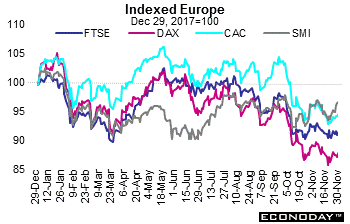 European equities advanced on the week but were mixed on the month. On Friday, traders were reluctant to make any major moves ahead of this weekend's G-20 summit. U.S. President Donald Trump and Chinese President Xi Jinping will hold a highly anticipated dinner meeting on Saturday at the summit to discuss the trade dispute between the two nations on the sidelines of the G20 summit in Buenos Aires, Argentina. Weak Chinese data were a negative for the markets. European equities advanced on the week but were mixed on the month. On Friday, traders were reluctant to make any major moves ahead of this weekend's G-20 summit. U.S. President Donald Trump and Chinese President Xi Jinping will hold a highly anticipated dinner meeting on Saturday at the summit to discuss the trade dispute between the two nations on the sidelines of the G20 summit in Buenos Aires, Argentina. Weak Chinese data were a negative for the markets.
On the week, the FTSE was up 0.4 percent, the CAC advanced 1.2 percent, the DAX gained 0.6 percent and the SMI was 2.2 percent higher. In November however, the FTSE, CAC and DAX were down 2.1 percent, 1.8 percent and 1.7 percent respectively while the SMI edged up 0.2 percent. .
The presidents of the U.S. and China will hold a highly anticipated meeting at the summit to discuss the trade dispute between the two nations. Trump and Xi are due to hold a dinner meeting on Saturday (December 1) on the sidelines of the G20 summit in Buenos Aires, Argentina. Traders remained in a cautious mood due to lingering uncertainty about the trade dispute.
Analysts posit that a partial recovery in stock markets in December — also known as a “Santa rally” — hang on the leaders’ discussions that would result in a truce or de-escalation of the U.S.-China trade war. “There are only two people in the world that can deliver a Santa rally, Trump and Xi. China reported its weakest factory growth in more than two years on Friday, reigniting fears about growth ahead of crucial trade talks.
Equities were boosted during the week fueled by dovish comments from Federal Reserve Chairman Jerome Powell. Powell said that U.S. interest rates were just below neutral, implying that the Fed's three-year tightening cycle is drawing to a close.
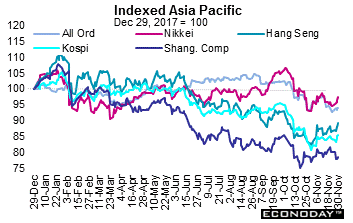 Most Asian equity indexes advanced on the week — only the All Ordinaries (down 0.8 percent) and the KLCI (down 0.9 percent) retreated. On a monthly basis, performance improved in November. While all indexes tumbled in October, only four continued to decline in November. They were the All Ordinaries, Shanghai Composite, KLCI and SET. Most Asian equity indexes advanced on the week — only the All Ordinaries (down 0.8 percent) and the KLCI (down 0.9 percent) retreated. On a monthly basis, performance improved in November. While all indexes tumbled in October, only four continued to decline in November. They were the All Ordinaries, Shanghai Composite, KLCI and SET.
The Fed minutes which were released Thursday from the most recent Fed meeting on November 7 and 8 added weight to expectations for a rate increase in December. Caution also set in ahead of the highly-anticipated meeting between U.S. President Donald Trump and his Chinese counterpart Xi Jinping at the G-20 summit in Argentina on the weekend. Comments from members of the U.S. administration gave various opinions on the outcome of the Trump/Xi talks. Asian stocks outside of Japan ended higher in November, their first monthly advance since July, as indications of a slowing pace of future rate increases from the U.S. Federal Reserve boosted regional sentiment, while some heavyweights advanced on earnings.
After President Donald Trump rattled investors by talking tough ahead of a highly-anticipated meeting with Chinese President Xi Jinping in Argentina on Saturday, White House economic adviser Larry Kudlow sought to brighten the mood by holding open the possibility that the two countries would reach a trade deal. Beijing’s ambassador to Washington, Cui Tiankai, told Reuters that China is going to the G-20 summit hoping for a deal to ease a damaging trade war with the United States, though he warned of dire consequences if U.S. hardliners try to separate the world’s two largest economies. All in all, it was still unclear whether the two sides had agreed on a formal agenda for the Trump-Xi meeting after the G20 summit and Kudlow said there were no scheduled talks on the ground for their advisers.
Some disappointing data, suggesting that China's manufacturing activity continued to worsen in November, were released. The weak manufacturing growth reinforced expectations that Beijing will roll out more economic support measures — a factor that has helped to prop up battered Chinese equities recently. The manufacturing PMI stood at the breakeven point of 50.0 in November, down from 50.2 in October. The non-manufacturing PMI was 53.4, down from 53.9 in the previous month. The composite index posted a reading of 52.8, down from 53.1 a month earlier.
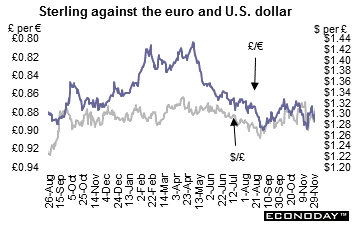 The U.S. dollar advanced against most of its major counterparts. It was up against the euro, pound sterling, Swiss franc, yen and Canadian dollar but retreated against the Australian dollar. Sterling declined Friday and was headed for a third consecutive week of losses as caution grew among investors about the British parliament’s vote on Brexit next month. The U.S. dollar advanced against most of its major counterparts. It was up against the euro, pound sterling, Swiss franc, yen and Canadian dollar but retreated against the Australian dollar. Sterling declined Friday and was headed for a third consecutive week of losses as caution grew among investors about the British parliament’s vote on Brexit next month.
UK Prime Minister Theresa May said on Thursday she was focused on persuading MPs to back her divorce deal with the European Union in a December 11 vote rather than preparing a plan B. May secured an agreement with EU leaders on November 25 that will see Britain leave the bloc in March 2019 with continued close trade ties. However, the odds are slim in getting it through the Parliament. The worries were reflected in the currency markets.
|
|
2017 |
2018 |
% Change |
|
|
Dec 29 |
Nov 23 |
Nov 30 |
Week |
2018 |
| U.S. $ per currency |
|
|
|
|
|
|
| Australia |
A$ |
0.779 |
0.723 |
0.731 |
1.2% |
-6.2% |
| New Zealand |
NZ$ |
0.709 |
0.678 |
0.688 |
1.4% |
-3.0% |
| Canada |
C$ |
0.796 |
0.756 |
0.752 |
-0.4% |
-5.4% |
| Eurozone |
euro (€) |
1.194 |
1.135 |
1.132 |
-0.3% |
-5.2% |
| UK |
pound sterling (£) |
1.344 |
1.284 |
1.275 |
-0.7% |
-5.2% |
|
|
|
|
|
|
|
| Currency per U.S. $ |
|
|
|
|
|
|
| China |
yuan |
6.534 |
6.949 |
6.961 |
-0.2% |
-6.1% |
| Hong Kong |
HK$* |
7.816 |
7.826 |
7.824 |
0.0% |
-0.1% |
| India |
rupee |
64.081 |
70.696 |
69.584 |
1.6% |
-7.9% |
| Japan |
yen |
112.850 |
112.950 |
113.500 |
-0.5% |
-0.6% |
| Malaysia |
ringgit |
4.067 |
4.191 |
4.184 |
0.2% |
-2.8% |
| Singapore |
Singapore $ |
1.338 |
1.375 |
1.372 |
0.2% |
-2.5% |
| South Korea |
won |
1070.630 |
1130.450 |
1120.750 |
0.9% |
-4.5% |
| Taiwan |
Taiwan $ |
29.775 |
30.904 |
30.820 |
0.3% |
-3.4% |
| Thailand |
baht |
32.696 |
33.076 |
32.949 |
0.4% |
-0.8% |
| Switzerland |
Swiss franc |
0.979 |
0.9974 |
0.999 |
-0.2% |
-2.1% |
| *Pegged to U.S. dollar |
|
|
|
|
|
|
| Source: Bloomberg |
|
|
|
|
|
|
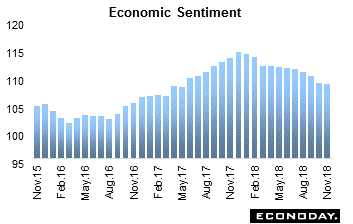 November sentiment reading of 109.5 was minimally weaker than the revised October mark of 109.7 — but this was still its eleventh decrease in as many months. The outcome was the worst since May 2017. The latest fall reflected softer morale among households. Sentiment in both services and in construction was unchanged and both retail and industry posted minor gains. Among the larger Eurozone states, the national ESI edged higher in both France (104.8 after 104.6) and Germany (111.8 after 111.2) and dipped in Spain (107.1 after 107.4). However, Italy (105.9 after 107.1) recorded a sizeable decline that will fuel speculation about a possible contraction in fourth quarter real GDP. Meantime, the inflation outlook was mixed. Expected selling prices in manufacturing (11.3 after 9.7) recovered most of October's loss but were still comfortably below the levels seen around the turn of the year while their services counterpart (9.7 after 8.5) recorded their highest mark of 2018 so far. However, household inflation expectations (21.1 after 21.6) were a little softer albeit still at their second strongest level in 2018. November sentiment reading of 109.5 was minimally weaker than the revised October mark of 109.7 — but this was still its eleventh decrease in as many months. The outcome was the worst since May 2017. The latest fall reflected softer morale among households. Sentiment in both services and in construction was unchanged and both retail and industry posted minor gains. Among the larger Eurozone states, the national ESI edged higher in both France (104.8 after 104.6) and Germany (111.8 after 111.2) and dipped in Spain (107.1 after 107.4). However, Italy (105.9 after 107.1) recorded a sizeable decline that will fuel speculation about a possible contraction in fourth quarter real GDP. Meantime, the inflation outlook was mixed. Expected selling prices in manufacturing (11.3 after 9.7) recovered most of October's loss but were still comfortably below the levels seen around the turn of the year while their services counterpart (9.7 after 8.5) recorded their highest mark of 2018 so far. However, household inflation expectations (21.1 after 21.6) were a little softer albeit still at their second strongest level in 2018.
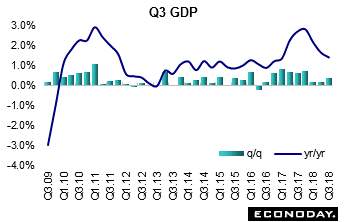 Third quarter GDP was unrevised at a quarterly 0.4 percent increase from the second quarter when it expanded just 0.2 percent. However, the workday adjusted annual expansion rate was trimmed from 1.5 percent to 1.4 percent, down 0.2 percentage points from last time. As previously reported, the quarterly acceleration was mainly attributable to a rebound in household consumption which was up 0.4 percent after falling 0.2 percent in the three months to June. Growth of government consumption (0.2 percent) was down a tick while gross fixed capital formation (0.9 percent) held steady. Inventory building subtracted 0.3 percentage points which just more than unwound the previous period's boost. Net exports were revised a little firmer. Exports now show a 0.4 percent increase which, with imports off 0.3 percent, made for a net contribution of 0.2 percentage points. This reversed the 0.2 percentage point hit from last time. Third quarter GDP was unrevised at a quarterly 0.4 percent increase from the second quarter when it expanded just 0.2 percent. However, the workday adjusted annual expansion rate was trimmed from 1.5 percent to 1.4 percent, down 0.2 percentage points from last time. As previously reported, the quarterly acceleration was mainly attributable to a rebound in household consumption which was up 0.4 percent after falling 0.2 percent in the three months to June. Growth of government consumption (0.2 percent) was down a tick while gross fixed capital formation (0.9 percent) held steady. Inventory building subtracted 0.3 percentage points which just more than unwound the previous period's boost. Net exports were revised a little firmer. Exports now show a 0.4 percent increase which, with imports off 0.3 percent, made for a net contribution of 0.2 percentage points. This reversed the 0.2 percentage point hit from last time.
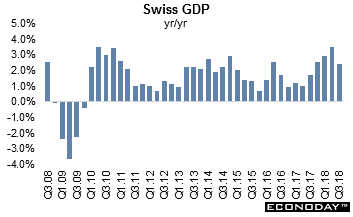 Third quarter GDP unexpectedly contracted 0.2 percent following an unrevised 0.7 percent quarterly increase in April to June — its first fall since the fourth quarter of 2016. Annual workday adjusted growth slowed from 3.5 percent to 2.4 percent. The much weaker than expected quarterly outcome reflected sluggish household spending and, in particular, a decline in investment in equipment and software. Construction investment only stagnated while general government consumption subtracted. This left business inventories, which boosted growth by a full 1.0 percent, to offer the only real support although this may well prove to be at the expense of the current quarter. The other major hit came from net foreign trade where a hefty 4.2 percent slide in goods exports (excluding valuables) was almost double the 2.4 percent decline in imports. Exports of services (down 0.6 percent) were also well behind their import counterpart which was unchanged. Inflation developments were broadly neutral with the yearly change in the GDP deflator easing just a tick to 1.0 percent, only its second consecutive positive print. Third quarter GDP unexpectedly contracted 0.2 percent following an unrevised 0.7 percent quarterly increase in April to June — its first fall since the fourth quarter of 2016. Annual workday adjusted growth slowed from 3.5 percent to 2.4 percent. The much weaker than expected quarterly outcome reflected sluggish household spending and, in particular, a decline in investment in equipment and software. Construction investment only stagnated while general government consumption subtracted. This left business inventories, which boosted growth by a full 1.0 percent, to offer the only real support although this may well prove to be at the expense of the current quarter. The other major hit came from net foreign trade where a hefty 4.2 percent slide in goods exports (excluding valuables) was almost double the 2.4 percent decline in imports. Exports of services (down 0.6 percent) were also well behind their import counterpart which was unchanged. Inflation developments were broadly neutral with the yearly change in the GDP deflator easing just a tick to 1.0 percent, only its second consecutive positive print.
 India's gross domestic product increased 7.1 percent on the year in the three months to September, slowing from 8.2 percent in the three months to June. This decline follows four consecutive increases in annual growth. Agriculture, forestry and fishing, manufacturing, construction and mining were weaker and were partly offset by stronger growth in utilities, public administration and parts of the services sector. The quarterly growth estimate was preceded by a political row over the integrity of the Central Statistics Office which produces the calculations. India's gross domestic product increased 7.1 percent on the year in the three months to September, slowing from 8.2 percent in the three months to June. This decline follows four consecutive increases in annual growth. Agriculture, forestry and fishing, manufacturing, construction and mining were weaker and were partly offset by stronger growth in utilities, public administration and parts of the services sector. The quarterly growth estimate was preceded by a political row over the integrity of the Central Statistics Office which produces the calculations.
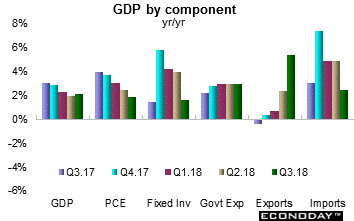 Third quarter gross domestic product was up 0.5 percent on the quarter and 2.0 percent when compared with a year ago. Final domestic demand was unchanged, constrained by falling investment, while export volumes edged up 0.2 percent. Strength in the mining and petroleum refining industries boosted corporate earnings. On an annualized rate, GDP was up 2.0 percent. Strength in mining and petroleum refineries boosted growth in the third quarter. These industries benefited from higher prices and foreign demand. Generally, production recoveries drew on domestically produced inputs. Strength was also evident in service industries including real estate. Growth in household spending slowed from 0.6 percent in the second quarter to 0.3 percent in the third quarter. Import volumes declined 2.0 percent in the third quarter, with imports of refined petroleum products falling 27.2 percent. Growth in export volumes slowed to 0.2 percent in the third quarter, following a 3.1 percent increase in the second quarter. Total goods exports rose 0.4 percent, led by shipments of metal ores and non-metallic minerals (27.6 percent). This largely reflected the resumption of operations at mines affected by work stoppages in the second quarter. Third quarter gross domestic product was up 0.5 percent on the quarter and 2.0 percent when compared with a year ago. Final domestic demand was unchanged, constrained by falling investment, while export volumes edged up 0.2 percent. Strength in the mining and petroleum refining industries boosted corporate earnings. On an annualized rate, GDP was up 2.0 percent. Strength in mining and petroleum refineries boosted growth in the third quarter. These industries benefited from higher prices and foreign demand. Generally, production recoveries drew on domestically produced inputs. Strength was also evident in service industries including real estate. Growth in household spending slowed from 0.6 percent in the second quarter to 0.3 percent in the third quarter. Import volumes declined 2.0 percent in the third quarter, with imports of refined petroleum products falling 27.2 percent. Growth in export volumes slowed to 0.2 percent in the third quarter, following a 3.1 percent increase in the second quarter. Total goods exports rose 0.4 percent, led by shipments of metal ores and non-metallic minerals (27.6 percent). This largely reflected the resumption of operations at mines affected by work stoppages in the second quarter.
Equities were mixed both for the week and month. Trading was subdued at week’s end as investors waited for the result of the Trump-Xi dinner. Data were mixed last week.
Three central bank meetings will be held next week. The Reserve Banks of Australia and India along with the Bank of Canada will hold policy meetings. The three will most likely leave their respective policies unchanged. There is also a slew of updated economic data including final manufacturing, services and composite PMIs for November. Australia will post third quarter GDP. And Germany will post October manufacturing orders and industrial production. The data will give the latest picture of the weakening German economy.
| Central Bank activities |
|
| Dec 4 |
Australia |
Reserve Bank of Australia Monetary Policy Announcement |
| Dec 5 |
India |
Reserve Bank of India Monetary Policy Announcement |
|
Canada |
Bank of Canada Monetary Policy Announcement |
|
United States |
Federal Reserve Beige Book Published |
| |
|
|
| The following indicators will be released this week... |
| Europe |
|
|
| Dec 3 |
EZ |
Manufacturing PMI (November) |
|
Germany |
Manufacturing PMI (November) |
|
France |
Manufacturing PMI (November) |
|
Italy |
Manufacturing PMI (November) |
|
Spain |
Manufacturing PMI (November) |
|
UK |
Manufacturing PMI (November) |
| Dec 4 |
EZ |
Producer Price Index (October) |
| Dec 5 |
EZ |
Services & Composite PMI (November) |
|
|
Retail Sales (October) |
|
Germany |
Services & Composite PMI (November) |
|
France |
Services & Composite PMI (November) |
|
Italy |
Services & Composite PMI (November) |
|
Spain |
Services & Composite PMI (November) |
|
UK |
Services PMI (November) |
| Dec 6 |
Germany |
Manufacturing Orders (October) |
| Dec 7 |
EZ |
Gross Domestic Product (Q3.2018 final) |
|
Germany |
Industrial Production (October) |
|
France |
Industrial Production (October) |
|
|
Merchandise Trade (October) |
| |
|
|
| Asia Pacific |
|
|
| Dec 3 |
Japan |
Manufacturing PMI (November) |
| Dec 5 |
Japan |
Services PMI (November) |
|
Australia |
Gross Domestic Product (Q3.2018) |
| Dec 6 |
Australia |
Retail Sales (October) |
|
|
Merchandise Trade Balance October) |
| |
|
|
| Americas |
|
|
| Dec 6 |
Canada |
International Trade (October) |
| Dec 7 |
Canada |
Labour Force Survey (November) |
|
|
Employment Situation (November) |
Anne D Picker is the author of International Economic Indicators and Central Banks.
|

